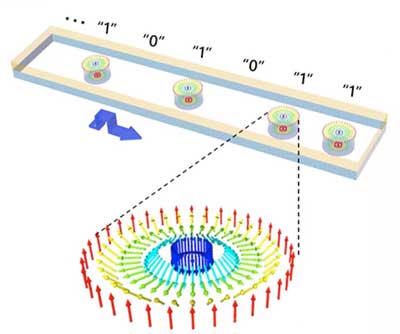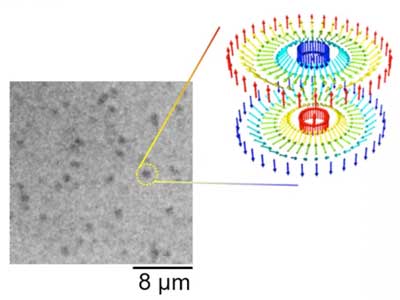| Nov 20, 2019 | |
The first high-speed straight motion of magnetic skyrmion at room temperature demonstrated(Nanowerk News) Researchers at Tohoku University have, for the first time, successfully demonstrated a formation and current-induced motion of synthetic antiferromagnetic magnetic skyrmions ("Formation and current-induced motion of synthetic antiferromagnetic skyrmion bubbles"). The established findings are expected to pave the way towards new functional information processing and storage technologies. |
|
 |
|
| Schematic of magnetic skyrmion and magnetic devices utilizing skyrmion. (Image: Takaaki Dohi and Shunsuke Fukami) | |
| Magnetic skyrmion is known to be a topological object, emerged in magnetic systems. It possesses the ability to be made at nanoscale and to be driven by a current, showing promise for various applications where information is represented by the presence, absence, number, or state of the skyrmion. However, there remains one stumbling block - the skyrmion Hall effect. | |
| The skyrmion Hall effect entails the skyrmion not moving along the current, but in the direction diagonal to the current because of the inherent angular momentum of the skyrmion, degrading the efficiency and stability of devices. As such, demand is high for technology that overcomes the skyrmion Hall effect. | |
| The research group - which includes Professor Hideo Ohno (current Tohoku University President), Associate Professor Shunsuke Fukami, and Ph.D. candidate Mr. Takaaki Dohi - developed a magnetic stack structure in which the skyrmion is moved along the current, avoiding the skyrmion Hall effect. | |
 |
|
| Kerr microscopy image of the formed skyrmions. (Image: Takaaki Dohi and Shunsuke Fukami) | |
| The developed structure effectively exploits three spintronics effects, Ruderman-Kittel-Kasuya-Yosida (RKKY) interaction, Dzyaloshinskii-Moriya (DM) interaction, and spin-orbit (SO) interaction. Due to the RKKY and DM interactions, a synthetic antiferromagnetically-coupled (SyAF) skyrmion is successfully formed. | |
| In addition, thanks to the SO interaction, the SyAF skyrmion is moved with a much smaller current than conventional single ferromagnetic skyrmion. Moreover, suppression of skyrmion Hall effect is confirmed for the SyAF system. | |
| This is the first demonstration of the formation and current-induced motion of magnetic skyrmion circumventing the skyrmion Hall effect at room temperature. Ultimately, the present finding is expected to open the pathway to newer spintronics devices in which topology arising in magnetic materials is fully utilized. |
| Source: Tohoku University | |
|
Subscribe to a free copy of one of our daily Nanowerk Newsletter Email Digests with a compilation of all of the day's news. |
